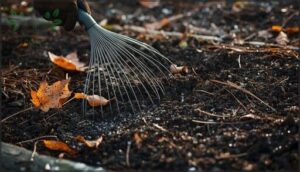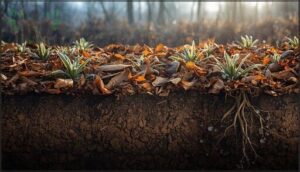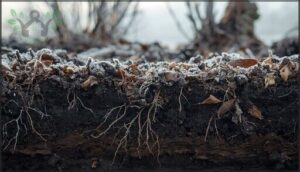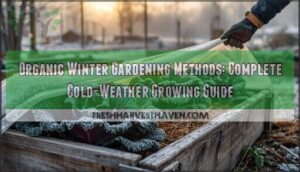This site is supported by our readers. We may earn a commission, at no cost to you, if you purchase through links.
Most gardeners pack away their tools when frost arrives, but the real work of building remarkable soil happens when your plants are sleeping. Winter isn’t downtime for your garden beds—it’s when organic matter breaks down most efficiently, when amendments integrate deeply without disturbing active roots, and when you can address structural problems that plague growing seasons.
Understanding dormant season garden soil health transforms those cold months from a gardening hiatus into your most strategic window for soil improvement.
The practices you implement now—from timing your compost applications to protecting against compaction on frozen ground—determine whether you’ll be fighting depleted, problematic soil come spring or working with a living foundation that’s been quietly rebuilding itself all winter.
Table Of Contents
- Key Takeaways
- Timing Dormant Season Soil Preparation
- Clearing and Protecting Garden Beds
- Improving Soil Health During Dormancy
- Managing Soil Nutrients and PH in Winter
- Preventing Soil Compaction and Pest Issues
- Frequently Asked Questions (FAQs)
- When should you plant dormant plants?
- How do you care for a dormant plant?
- Do dormant plants need a lot of care?
- What happens if a plant goes dormant in winter?
- How does dormancy affect plants?
- When do plants come out of dormancy?
- How does winter rain affect soil nutrient leaching?
- Can beneficial microbes survive frozen soil temperatures?
- Should bare soil be covered throughout winter?
- What causes soil crusting during winter months?
- Conclusion
Key Takeaways
- Winter is your most strategic window for soil improvement because organic matter breaks down efficiently during dormancy, amendments integrate deeply without disturbing roots, and you can address structural problems before the growing season begins.
- Apply 1-2 inches of mature compost and 2-4 inches of organic mulch after plants enter dormancy to stabilize soil temperature, reduce erosion by up to 98%, and deliver slow-release nutrients that sync perfectly with spring growth.
- Avoid walking on wet or frozen soil throughout winter because compaction crushes the pore spaces roots and oxygen need, making prevention now far easier than fixing damaged soil structure later.
- Test and adjust soil pH during dormancy by applying lime or sulfur 4-6 weeks before the ground freezes, giving amendments time to react through freeze-thaw cycles so plants wake up to ideal nutrient availability in spring.
Timing Dormant Season Soil Preparation
Getting the timing right makes all the difference when you’re preparing your garden soil for winter. You’ll need to know when dormancy actually begins in your area, keep an eye on frost patterns, and understand what your soil and plants are telling you.
Let’s look at the key factors that help you nail down the perfect window for dormant season prep.
Identifying Your Local Dormant Period
When does dormancy actually start in your area? That’s the first question to answer for effective winter soil management. Your local dormant season usually begins when temperatures drop to around 5°C (41°F) and daylight shortens, typically spanning late fall through early winter.
Planting during this period allows for optimal root growth, leading to reduced water stress and healthier plants come spring.
In colder hardiness zones, this might start in September, while milder climates may not see dormancy indicators until December, with microclimate effects and chilling hour needs varying considerably.
Monitoring First and Last Frost Dates
Knowing when frost arrives and departs shapes every winter soil management decision you make. First frost dates in your region might fall anywhere from late September in northern zones to late December in milder climates, with frost date variability of roughly two weeks around the average. Regional microclimates, elevation, and proximity to water bodies all influence timing, so here’s what to track:
- Use online frost calculators and local extension services for historical climate data
- Monitor real-time weather stations and frost alerts through mobile apps
- Assess climate change impact on shifting frost patterns in your area
- Document your own frost observations annually for frost risk assessment specific to you
These monitoring tools help you time soil amendments, mulching, and frost protection perfectly. It’s worth mentioning that average first frost dates vary by location and elevation.
Assessing Soil and Plant Readiness
Once you’ve mapped the frost calendar, your next step is reading what the soil and plants are actually telling you. Soil temperature, moisture levels, and physical properties reveal dormancy visuals that guide winter soil management decisions. Here’s what to check:
| Indicator | What to Look For |
|---|---|
| Soil Temperature | Below 50°F signals dormancy; track trends with a probe |
| Moisture Levels | Soil should crumble when squeezed, not clump or dust |
| Physical Properties | No compaction, gentle aeration, good drainage |
| Plant Signs | Brown but firm stems, flexible twigs, white roots |
| Nutrient Status | Stable pH readings, adequate organic matter present |
Winter dormant season soil testing now prevents spring surprises and strengthens soil health year-round.
Clearing and Protecting Garden Beds
Before winter sets in, you’ll want to clear your garden beds of debris and prepare them for the cold months ahead. This process protects your soil structure, prevents pest issues, and sets the stage for a healthier spring garden.
Let’s walk through the essential steps to get your beds ready for dormancy.
Removing Debris, Weeds, and Spent Crops
Your garden beds need clearing once daytime temperatures dip consistently below 50°F, but timing matters for beneficial insects.
Start with debris management by pulling weeds before they set seed—this weed prevention step cuts future pressure dramatically. Remove spent crop material, especially from nightshade and cucurbit families, to break pest control cycles and reduce disease carryover.
You’re protecting next season’s soil health with every handful cleared.
Gentle Raking and Surface Preparation
Once you’ve cleared debris, a light pass with a flexible leaf rake—keeping to just 1-2 inches deep—readies your soil surface without harming microbial communities or soil structure. This gentle approach offers real benefits for soil health:
- Breaks up surface crusts, reducing erosion by 10-15% while improving water infiltration
- Boosts oxygen availability to beneficial microbes by roughly 15%
- Speeds organic matter breakdown, with leaf litter decomposing 10-14% faster
- Preserves fungal networks that support nutrient cycling throughout dormancy
Rake too deep, though, and you’ll disrupt the beneficial organisms your garden depends on.
Erosion Control With Mulch and Ground Covers
After your raking pass, a 2-4 inch mulch layer cuts erosion by over 90% while stabilizing soil temperature through winter’s freeze-thaw cycles. Organic mulch at about 0.50 kg/m² reduces runoff and retains precious moisture, making it one of the most cost-effective covers you can apply.
Ground cover benefits extend beyond erosion control—they’ll improve soil structure and support microbial activity until spring arrives.
Improving Soil Health During Dormancy
Winter isn’t just a time to let your garden rest—it’s your best opportunity to rebuild what the growing season took from the soil. By adding the right materials now, you’ll boost nutrients, improve structure, and set yourself up for healthier plants come spring.
Here are three proven ways to enrich your soil while it’s dormant.
Adding Compost and Organic Matter
Think of fall compost as a winter savings account for your soil—deposits made now pay dividends come spring. After you’ve cleared your beds, spread a 1-2 inch layer of mature compost evenly across the soil surface.
Spread a 1-2 inch layer of mature compost in fall—it’s a winter savings account that pays spring dividends
Here’s what you’ll gain:
- Compost Nutrient Release: Slow nutrient delivery synchronized with spring growth
- Soil Structure Improvement: Enhanced aggregation reduces compaction
- Microbial Activity Boost: Beneficial organisms thrive, accelerating decomposition
- Water Retention Increase: Organic matter acts like a sponge
- Weed Suppression: Physical barrier blocks unwanted growth
Winter’s freeze-thaw cycles naturally work compost into the soil, enriching soil health and fertility without extra effort.
Applying Mulch for Insulation and Moisture Retention
Winter’s cold can be harsh on exposed soil, but mulch acts like a protective blanket. Apply 2-4 inches of organic mulch—straw, wood chips, or shredded leaves—after plants enter dormancy and freezing temperatures arrive. This depth provides effective soil insulation while reducing erosion by up to 98% and stabilizing temperature fluctuations by 36-39°F.
These mulching techniques slow evaporation and protect roots from freeze-thaw damage.
| Mulch Type | Insulation Quality | Moisture Retention |
|---|---|---|
| Straw | Excellent | High |
| Wood Chips | Very Good | Moderate |
| Shredded Leaves | Good | High |
| Pine Needles | Good | Moderate |
Incorporating Cover Crops for Nutrient Cycling
Cover crops function as living green manure, transforming your dormant garden into a nutrient factory. Winter rye, crimson clover, and radishes don’t just sit idle—they actively improve soil health through biological processes that set up next season’s success.
- Nitrogen fixation by legumes can contribute 100-400 kg per hectare, greatly reducing your spring fertilizer needs
- Carbon sequestration feeds soil microbial activity, creating that crumbly texture you’re after
- Deep root systems break up compacted layers while improving soil structure and water infiltration
- Erosion reduction occurs as cover crops intercept rainfall and hold topsoil in place
- Scavenging residual nutrients prevents leaching, with some species capturing over 200 kg nitrogen per hectare annually
Managing Soil Nutrients and PH in Winter
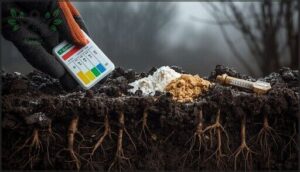
Winter offers a window to fine-tune your soil’s chemistry, so plants wake up to ideal conditions come spring. Testing your soil now reveals pH imbalances and nutrient gaps you can address while the ground is resting.
Let’s look at two key strategies for balancing your soil during the dormant months.
Adjusting PH With Lime or Sulfur
Your soil’s pH acts like a gatekeeper for nutrients, and winter gives you the perfect window to dial it in. Soil testing reveals whether you need lime to raise pH or sulfur to lower it—skipping this step is like cooking without tasting.
Here’s how lime application rates and sulfur application timing shape your results:
| Amendment | When to Apply | Expected pH Change |
|---|---|---|
| Lime (1000-1200 lb/acre) | Fall or early spring | Raises pH by 0.1 units |
| Broadcast lime (12 t/ha) | Before dormancy | Increases pH to 6.27 |
| Sulfur products | Fall with moisture present | Rapid decrease, gradual rebound |
Amendment incorporation methods matter—broadcasting lime creates broader pH shifts, while in-furrow placement stays localized. Apply amendments uniformly, then work them into the upper soil profile so they can react during winter’s freeze-thaw cycles.
Monitoring pH levels after application helps you fine-tune future treatments, ensuring your soil hits that sweet spot of around 6.5 for most crops.
Applying Amendments Before Freeze
Once you’ve balanced pH, timing your organic amendments becomes the next important move. Apply compost or aged manure 4-6 weeks before the ground freezes, when soil temps hover above 50°F—this window lets microbial activity break down materials and boost nutrient availability.
Amendment incorporation into the top 6-8 inches improves soil structure, aids erosion prevention, and sets you up for vibrant spring growth.
Preventing Soil Compaction and Pest Issues
Even during winter’s quiet months, your soil faces two major threats: compaction from foot traffic and pests waiting to wreak havoc come spring. Both problems are easier to prevent now than to fix later, and the steps you take during dormancy will pay off with healthier plants and looser, more productive soil.
Here’s how to protect your garden beds from these common winter challenges.
Avoiding Foot Traffic on Wet or Frozen Soil
When you walk on wet or frozen soil, you’re pressing soil particles together and shrinking the pore spaces that roots and oxygen need to thrive. This compaction prevention strategy is simple: designate mulch pathways through your beds, wait until soil dries before stepping in, and avoid frozen soil entirely.
Healthy soil structure preserved now means stronger plant growth come spring, making soil stabilization in winter a worthy investment.
Monitoring and Managing Overwintering Pests
Just as thoughtful footwork protects your soil structure, inspecting for overwintering pests safeguards next season’s health. Early dormant pest detection, through regular checks of bark crevices and soil surfaces, reveals pest egg ID clues before populations explode.
Effective pest management strategies include:
- Garden sanitation to remove debris sheltering pests
- Biological controls like ladybugs targeting emerging populations
- Horticultural oils applied during pest life cycles
- Structural proofing to seal entry points
Understanding climatic influences helps time interventions perfectly.
Planning Crop Rotation for Soil Recovery
After managing pests, you’re ready to map out next season’s planting strategy. Crop rotation during the dormant season rebuilds soil fertility and prevents nutrient depletion. A well-planned rotation duration of 3-4 years disrupts pest cycles while enhancing microbial health and soil structure.
| Rotation Year | Crop Type |
|---|---|
| Year 1 | Heavy feeders (tomatoes, squash) |
| Year 2 | Legumes for nutrient balancing (peas, beans) |
| Year 3 | Light feeders with cover crops |
This approach promotes yield stability while naturally enriching your soil.
Frequently Asked Questions (FAQs)
When should you plant dormant plants?
Plant dormant plants in late winter or early spring when soil temperature reaches 40°F-50°F and frost date impact lessens.
This timing—after soil thaws but before active growth—minimizes transplant shock and improves survival rates.
How do you care for a dormant plant?
Your dormant plant needs minimal watering—check soil moisture an inch deep and water slowly if dry.
Mulching insulates roots, maintains soil health, and protects against winter damage while preventing pest issues.
Do dormant plants need a lot of care?
No, dormant plants don’t demand much attention. You’ll reduce watering frequency, skip fertilizing, and monitor light requirements.
Focus on proper dormancy temperature, soil drainage, and occasional pest control to keep roots healthy through winter’s quiet months.
What happens if a plant goes dormant in winter?
When winter arrives, metabolic slowdown kicks in—your plant practically hits pause on growth, storing energy in roots for survival.
Freezing protection mechanisms activate, helping guarantee root health and improved pest resistance through the dormant season.
How does dormancy affect plants?
During dormancy depth peaks, gene downregulation reduces metabolic activity by up to 50%, while ABA expression increases membrane fluidity under cold.
This natural slowdown protects plant health, ensuring survival through harsh environmental conditions.
When do plants come out of dormancy?
As spring approaches, environmental signals like consistent temperatures above 45–50°F, lengthening daylight, and fulfilled chilling requirements trigger budburst timing.
Hormonal regulation reacts to these cues, ending your plants’ winter dormant season naturally.
How does winter rain affect soil nutrient leaching?
Heavy rainfall accelerates nutrient loss from garden beds, with phosphorus leaching doubling and nitrogen washing away faster during wet winters.
Soil type variability and freeze-thaw effects intensify winter soil protection challenges, making amendments essential.
Can beneficial microbes survive frozen soil temperatures?
Yes, beneficial microbes survive frozen soil through dormancy mechanisms and microbial freeze tolerance. While winter respiration drops and freeze-thaw impact reduces some populations, cold-adapted community shifts maintain soil health throughout the dormant season.
Should bare soil be covered throughout winter?
Covering your soil through winter isn’t optional—it’s essential. Mulch application and organic matter provide critical soil protection, preventing erosion control issues while boosting moisture retention, microbial activity, reducing nutrient leaching, and achieving compaction reduction for healthier spring gardens.
What causes soil crusting during winter months?
Winter can devastate soil structure—freeze-thaw cycles shatter aggregates, rainfall impact pounds surfaces, and bare soil composition invites compaction.
Surface exposure reduces infiltration rates, causing crusting that threatens your garden’s foundation.
Conclusion
What if the difference between struggling through spring and harvesting abundantly starts with the choices you make right now?
Your winter garden isn’t idle—it’s a living system that’s actively rebuilding itself. By protecting, amending, and planning during dormancy, you’re investing in dormant season garden soil health that compounds with every season.
When planting time arrives, you won’t be starting from scratch. You’ll be working with soil that’s already thriving.
- https://r.search.yahoo.com/_ylt=AwrPpj6u5Txn.QEAfL.zRwx.;_ylu=Y29sbwNzZzMEcG9zAzEEdnRpZAMEc2VjA3Ny/RV=2/RE=1733253807/RO=10/RU=https%3a%2f%2fwww.nrcs.usda.gov%2fconservation-basics%2fnatural-resource-concerns%2fsoils%2fsoil-health%2fsoil-health-assessment/RK=2/RS=1.OqQnV.CRdYUH7LgMwSUN2Ea.Y-
- https://rodaleinstitute.org/
- https://www.sare.org/
- https://perfectfitliving.com/home-improvement/
- https://www.owentree.com/how-does-organic-mulch-affect-soil-temperature-in-macomb-county-s-climate/



